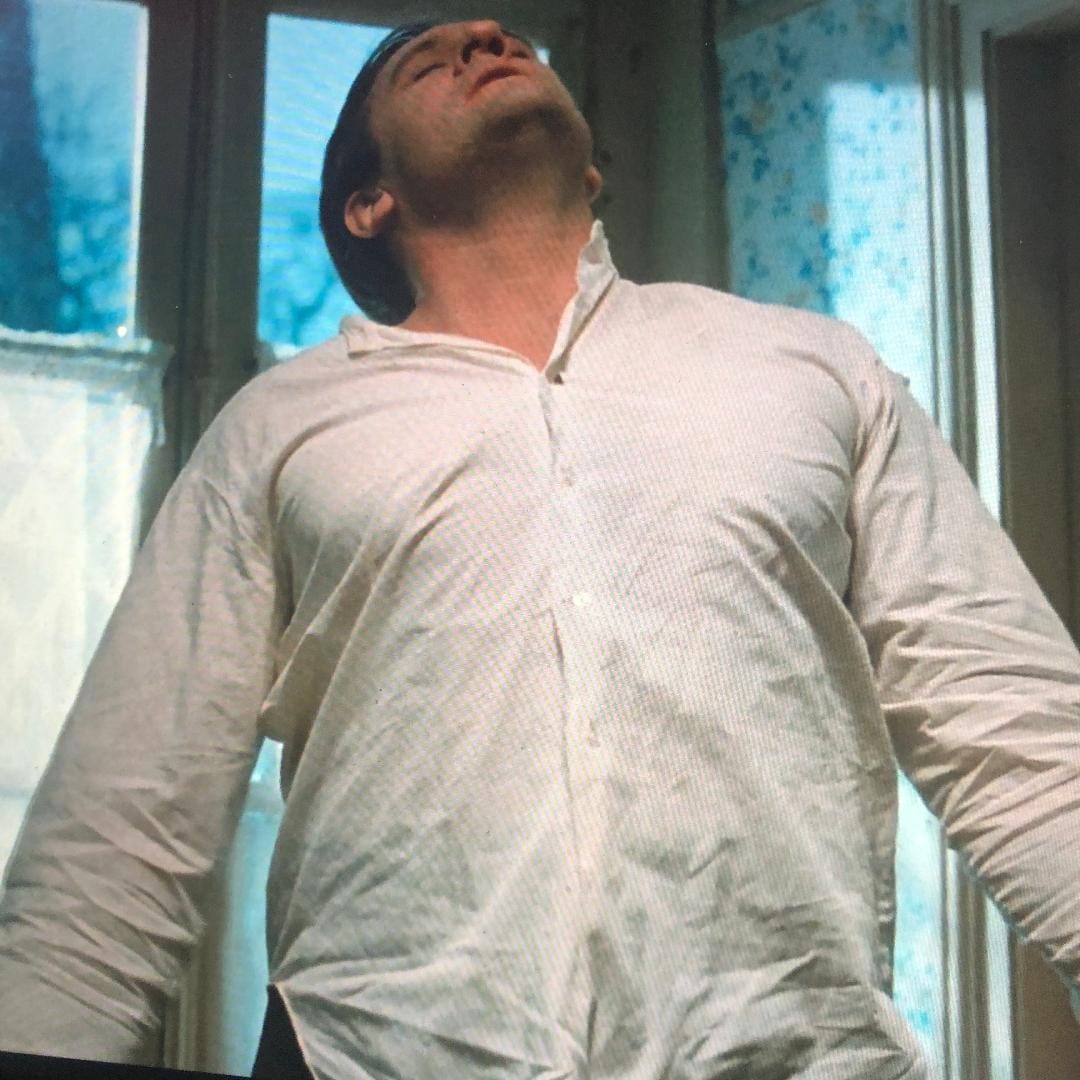NEW/OLD: Under the Sun of Satan

Two novels about unhappy priests by Georges Bernanos:
The Diary of a Country Priest (1936), about a young priest in a rural French village whose physical frailty from encroaching stomach cancer parallels the diminished faith of his parishioners. He can't pray or sleep or eat, and despairs over his failings in his vocation. I read it for the first time in the late 1980s for a comparative literature course, coincidentally as I happened to be backing slowly out the door of Evangelical Christianity. It’s a gloomy, haunted book that became a gloomy, haunted 1951 film from Robert Bresson. Personally, more than anything else, reading it felt like an appropriate goodbye.
Under the Sun of Satan (1926), published ten years before Diary, engages with illness, death, murder, suicide, and, almost as a dare for readers now as well as during the time of its publication, the existence of incontrovertible miracles. Standing in the middle of it all, engaged in battle with and devotion to the supernatural, is a priest named Donissan, the lone avatar of a disquieting religious faith, forced to deal with a teenage girl who’s murdered an older lover. Descriptions of the book called Bernanos’ writing style “fitful,” and that’s accurate. It feels as youthful and restless as its protagonist, and there’s a sense of afflicted agitation throughout. A devout, conservative Catholic, Bernanos’ ideas about faith are dark, intense, and confrontational rather than comforting. I just finished it last month – nearly 40 years after reading Diary and still fascinated by religious doom – coincidentally as the 1987 Palme d’Or-winning film version from director Maurice Pialat hit the Criterion Channel.
Two scenes from the film adaptation of Under the Sun of Satan:
A large, strapping man is whipping himself with a short chain. He wears a white shirt, and his powerful torso leans into the self-inflicted pain, begging for more. When he’s finished, he collapses, exhausted, and nearly faints. He’s doing this for God.
The man sets out on foot across the countryside, walking into the night, trudging and stumbling and eventually getting lost in the dark, where he’ll meet the physical manifestation of Satan. This is also for God.
The man is the aforementioned Donissan, played by Gerard Depardieu in one of his most intense film performances. Depardieu worked several times with Pialat, a post–New Wave director who specialized in a sobering, unsentimental realism, where attraction and repulsion were inextricably linked. His films mined the mysteries of human behavior: mania, obsession, abuse, loneliness, and unrewarded desire. He would return more than once to the subject of abandonment.
L’enfance nue (1968), Pialat’s first feature, depicts just such an abandonment, as a child grows more and more emotionally volatile while bouncing from one foster home to another. We Won’t Grow Old Together (1972) barrels into the darkness of an abusive relationship between a man and woman who can’t stand each other and can’t stand to be apart. In À Nos Amours (1983), a teenage girl careens from lover to lover for what seem like inscrutable reasons, but her family’s behavior provides clues.
Depardieu’s priest in Under the Sun of Satan is a somber ascetic, his silence cloaking a frenzied interior spiritual life. He understands himself and the world as abandoned by God, doomed to struggle against evil and all beckoning comforts. At one point in the film, rejecting the train – because of course he rejects the train – he sets out on the previously mentioned long night walk to another village. Cinematographer Willy Kurant’s gorgeous green landscape, wide and long and darkening by the moment, swallows the priest whole as he tackles the hills, disorienting him and then dooming him to whatever meets him in the dark. It’s a relatively brief moment, austere and visually precise, full atmospheric loneliness.
Two songs about the devil:
The Louvin Brothers, “Satan is Real” – Mid-century Southern gospel sincerity. It means to break your heart and your will. The beautiful family-based harmonies maintain the song’s allure, which cuts into the message. Why would you want to reject the world’s pleasures when stuff like this feels so good? Bonus confusion: album cover art of a bright red, horned figure that grins itself headfirst into camp.
Sonic Youth, “Satan is Boring” – Flippantly titled mid-80s noise dirge. As distorted and aurally evil as the Louvins’ song is gorgeous, and, perhaps inadvertently, effectively more in line with the gospel star brothers’ understanding of that dark entity. Created during and almost certainly mocking the decade’s “Satanic Panic” cultural moment, it’s a secular thesis that sounds like it came from Hell, not unlike Pialat’s interpretation of Bernanos’ devil-made-flesh.
Donissan trudges along on his night walk, immune to the beauty of his surroundings and unable to experience joy outside of the context of punishing obedience. Everything about him seems determined to encounter a malevolent force, and he gets his secret wish in the form of Satan himself (played by Jean-Christophe Bouvet). Of course, he’s not the Louvins’ cartoonish figure or an easily vanquished fool who’s unprepared for a warrior priest. Smaller in stature than Donissan, he’s a horse trader, a talker, and oddly flirtatious, the guy seated next to you on an airplane who keeps trying to strike up a conversation about nothing. Not “boring,” really, but definitely tedious and banal, at least until he makes his move.
Here, supernatural warfare is absolute physical reality, analogous to the New Testament story of Christ’s wilderness temptation. At one point during their meeting, the horse trader presses his body to the priest, kissing him as they lie on the ground in the cold night. Then, he wipes his lips – a shark spitting out bad-tasting human flesh – only to be understood for who he is and consequently rejected by the true believer. Made furious by the resistance, the businessman imparts a grave and horrible gift, cursing Donissan with the ability to see into the souls of every person he meets, then leaving the priest unconscious by the side of the road.
Two filmmakers approaching Georges Bernanos:
Bresson: His work steadfastly distilled performance and narrative to elemental forms. A Catholic, his films from Diary through Au hazard Balthazar to Mouchette (also from a novel by Bernanos) explored suffering and redemption. In later films, he’d start to feel a lot like an atheist, which happens. To paraphrase a Film Comment interview with Bresson by filmmaker Paul Schrader: his answers, usually, are not in tune with your questions.
Pialat: An atheist who, from film to film, regardless of the subject, worked with a detached and often stern gaze that was never condescending. Your questions are his questions, but answers aren’t coming any time soon. In Under the Sun, his secular approach takes seriously the vocation of religious life and its belief in literal demons, resurrections, and curses. Bodies on screen, subject to varieties of violence – self-inflicted, or delivered by external forces – are also the objects of transcendence.
The ability to see through to the worst parts of a soul, though imparted as a Satanic challenge, meant to overwhelm Donissan, arrives only after the priest dares his own body to withstand brutal self-mortification. It’s another short scene, less than a minute long, and though it’s the narrowly confined opposite of witnessing Donissan outdoors, tiny and cast against nature, the terrible loneliness is even more pronounced. He’s nearly too big for the frame in the punishing, penitent solitude of his room. There’s no space for camp to dilute it and make it laughable. It’s not Paul Bettany whipping himself in a ridiculous Da Vinci Code movie. It’s something else, communicated by Donissan’s/Depardieu’s body under duress and Pialat’s reserved refusal to look away.
There’s also no getting around the unexpected intrusion of eroticism, thanks to Depardieu’s 80s status as arthouse sex symbol and his prominent physical presence; he’s too big, broad and morosely handsome. His body, captured by Pialat’s fixed, unflinching camera, is a paradoxical presence. We don’t see the skin-shredding chain make contact; we see only a man stripped to a white shirt, the sun streaming into the brightly lit room, the chain wrapping around his torso, his gasps and moans, his heaving breath, the way he flings his arms back mimicking a crucifixion, and the ecstatic release and collapse when he finishes, gesturing analogously to orgasm. The pleasure is the pain until pleasure is erased. Sublimating sex, it’s an attention paid to the body in order to displace that attention. His mentor (played by Pialat himself), discovering the wounds on the young priest's chest, urges Donissan to put an end to the self-harm, telling him, “Our lord is not displeased with you.” Like that’s going to stop the urge.
Donissan’s concern is desire: to have none of it in order to be useful, even if he has to engage with evil, the misunderstanding of the people around him, or his own troubled body to get there. Pialat’s concern is human nature as it struggles through impossible belief and equally impossible religious perfectionism, and he looks intently and directly into the desire to be, quite literally, “baptized into [Christ’s] death” (Romans 6:3).
Miracles transpire, in the end, but they come at an equivalent cost, and with no great sense of triumph, just another chapter in an unseen war where nothing is won or proved besides the pervasive feeling that good and evil are interdependent forces. Here, Satan is real, but he’s only trying to give you that little push you need to reach the next station of the cross.


